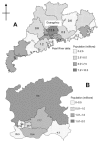Epidemiologic clues to SARS origin in China
- PMID: 15207054
- PMCID: PMC3323155
- DOI: 10.3201/eid1006.030852
Epidemiologic clues to SARS origin in China
Abstract
An epidemic of severe acute respiratory syndrome (SARS) began in Foshan municipality, Guangdong Province, China, in November 2002. We studied SARS case reports through April 30, 2003, including data from case investigations and a case series analysis of index cases. A total of 1,454 clinically confirmed cases (and 55 deaths) occurred; the epidemic peak was in the first week of February 2003. Healthcare workers accounted for 24% of cases. Clinical signs and symptoms differed between children (<18 years) and older persons (> or =65 years). Several observations support the hypothesis of a wild animal origin for SARS. Cases apparently occurred independently in at least five different municipalities; early case-patients were more likely than later patients to report living near a produce market (odds ratio undefined; lower 95% confidence interval 2.39) but not near a farm; and 9 (39%) of 23 early patients, including 6 who lived or worked in Foshan, were food handlers with probable animal contact.
Figures





Similar articles
-
[Severe acute respiratory syndrome in Guangdong Province of China: epidemiology and control measures].Zhonghua Yu Fang Yi Xue Za Zhi. 2003 Jul;37(4):227-32. Zhonghua Yu Fang Yi Xue Za Zhi. 2003. PMID: 12930668 Chinese.
-
Epidemiological characteristics of an outbreak of severe acute respiratory syndrome in Dongcheng District of Beijing from March to May 2003.Biomed Environ Sci. 2003 Dec;16(4):305-13. Biomed Environ Sci. 2003. PMID: 15011961
-
Children hospitalized with severe acute respiratory syndrome-related illness in Toronto.Pediatrics. 2003 Oct;112(4):e261. doi: 10.1542/peds.112.4.e261. Pediatrics. 2003. PMID: 14523209
-
Severe acute respiratory syndrome in children.Pediatr Infect Dis J. 2007 Jan;26(1):68-74. doi: 10.1097/01.inf.0000247136.28950.41. Pediatr Infect Dis J. 2007. PMID: 17195709 Review.
-
Severe acute respiratory syndrome epidemic in Taiwan, 2003.J Microbiol Immunol Infect. 2005 Apr;38(2):82-8. J Microbiol Immunol Infect. 2005. PMID: 15843851 Review.
Cited by
-
A Narrative Review on the Pandemic Zoonotic RNA Virus Infections Occurred During the Last 25 Years.J Epidemiol Glob Health. 2024 Oct 8. doi: 10.1007/s44197-024-00304-7. Online ahead of print. J Epidemiol Glob Health. 2024. PMID: 39378018 Review.
-
Genetic tracing of market wildlife and viruses at the epicenter of the COVID-19 pandemic.Cell. 2024 Sep 19;187(19):5468-5482.e11. doi: 10.1016/j.cell.2024.08.010. Cell. 2024. PMID: 39303692
-
One health: a structured review and commentary on trends and themes.One Health Outlook. 2024 Aug 14;6(1):17. doi: 10.1186/s42522-024-00111-x. One Health Outlook. 2024. PMID: 39138554 Free PMC article. Review.
-
Droplet Digital RT-PCR (dd RT-PCR) Detection of SARS-CoV-2 in Honey Bees and Honey Collected in Apiaries across the Campania Region.Viruses. 2024 May 4;16(5):729. doi: 10.3390/v16050729. Viruses. 2024. PMID: 38793611 Free PMC article.
-
Hibernating vesper bats are a weak source for biomonitoring of coronaviruses.One Health. 2024 Apr 23;18:100733. doi: 10.1016/j.onehlt.2024.100733. eCollection 2024 Jun. One Health. 2024. PMID: 38694618 Free PMC article.
References
-
- World Health Organization. WHO issues global alert about cases of atypical pneumonia: cases of severe respiratory illness may spread to hospital staff. Geneva. Organization. 2003; (March):12 Available from http://www.who.int/csr/sars/archive/2003_03_12/en/ Accessed January 21 2004.
Publication types
MeSH terms
LinkOut - more resources
Full Text Sources
Miscellaneous
